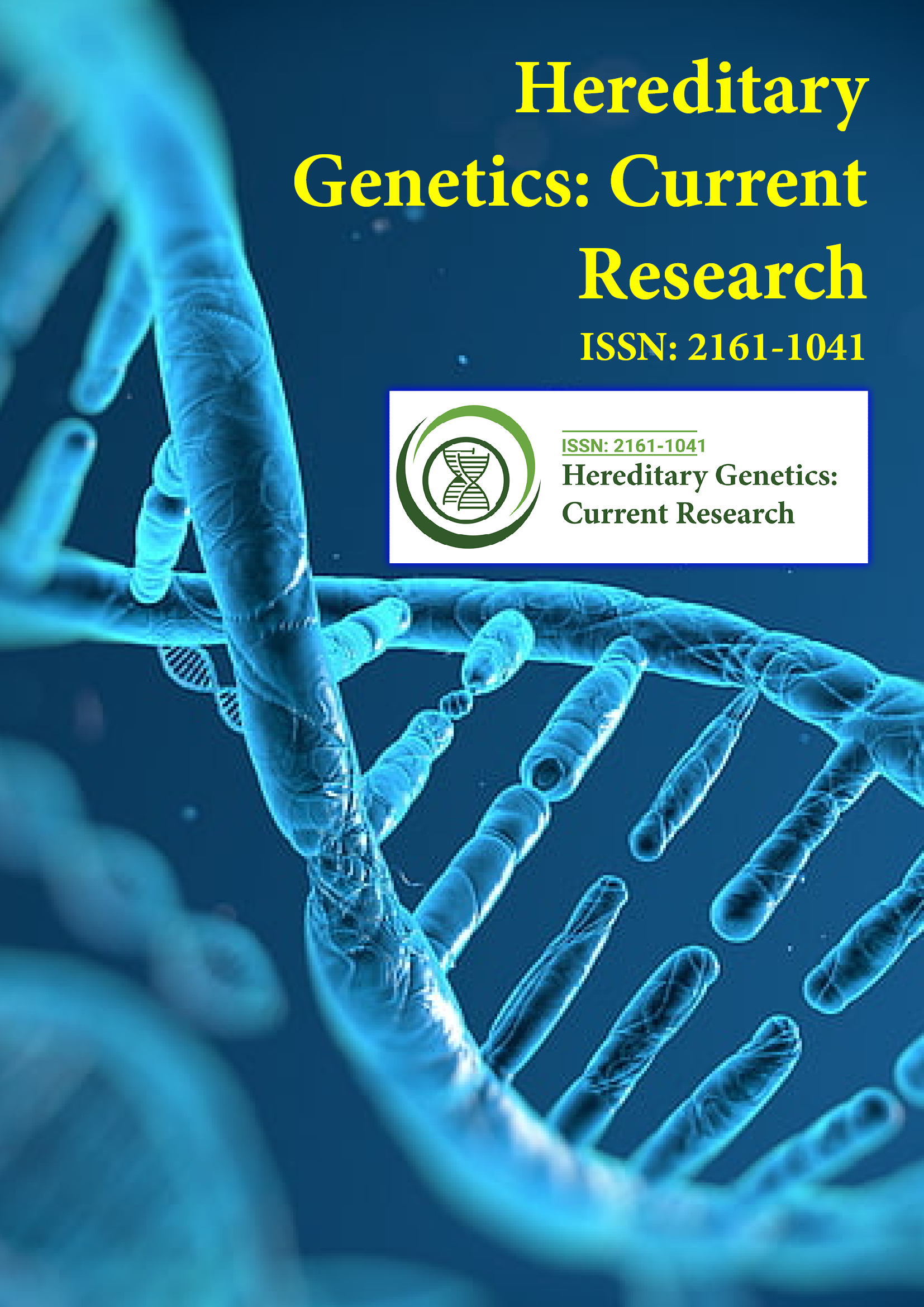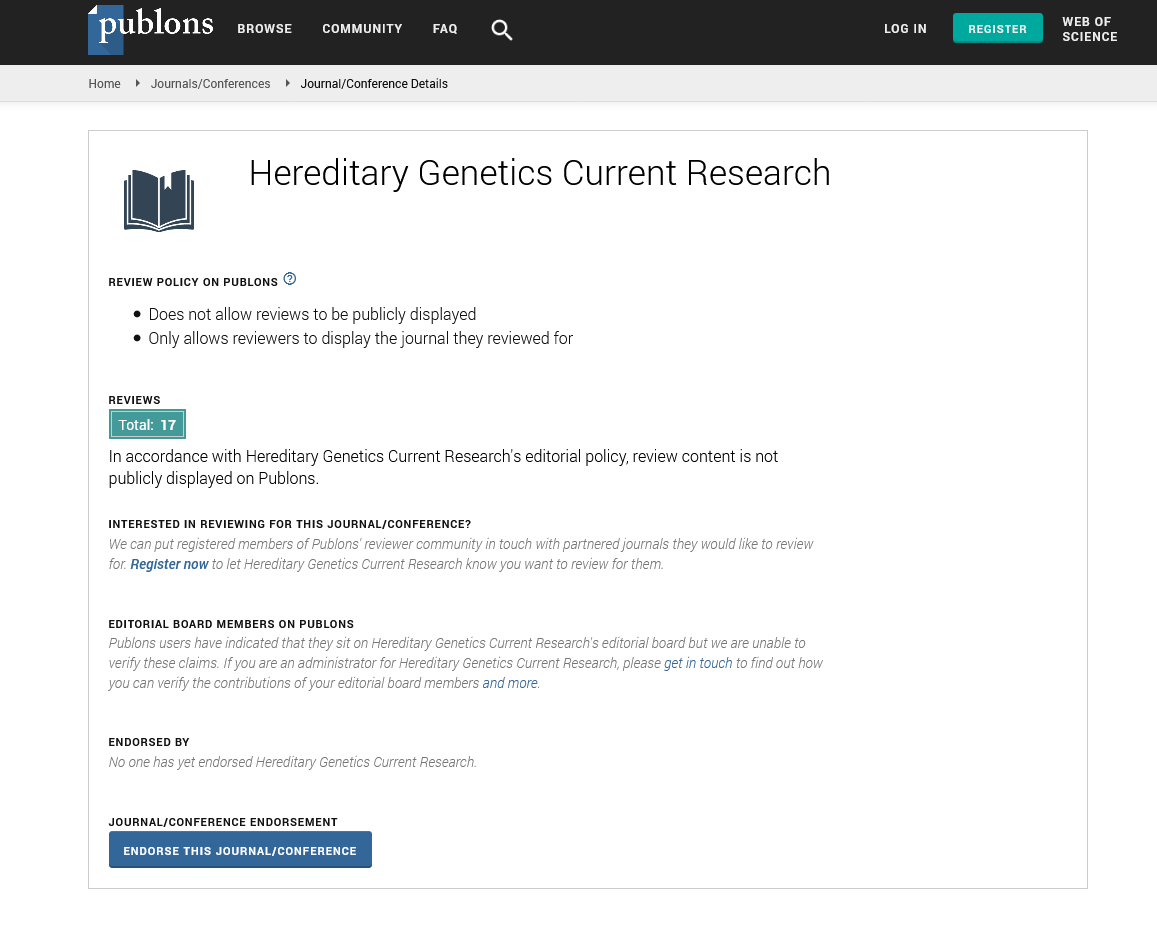Indexed In
- Open J Gate
- Genamics JournalSeek
- CiteFactor
- RefSeek
- Hamdard University
- EBSCO A-Z
- NSD - Norwegian Centre for Research Data
- OCLC- WorldCat
- Publons
- Geneva Foundation for Medical Education and Research
- Euro Pub
- Google Scholar
Useful Links
Share This Page
Journal Flyer

Open Access Journals
- Agri and Aquaculture
- Biochemistry
- Bioinformatics & Systems Biology
- Business & Management
- Chemistry
- Clinical Sciences
- Engineering
- Food & Nutrition
- General Science
- Genetics & Molecular Biology
- Immunology & Microbiology
- Medical Sciences
- Neuroscience & Psychology
- Nursing & Health Care
- Pharmaceutical Sciences
Commentry - (2024) Volume 13, Issue 1
Distribution Chromosomal Abnormalities in Term Placental Tissues
Lin Yang*Received: 27-Feb-2024, Manuscript No. HGCR-24-26557; Editor assigned: 01-Mar-2024, Pre QC No. HGCR-24-26557 (PQ); Reviewed: 15-Mar-2024, QC No. HGCR-24-26557; Revised: 22-Mar-2024, Manuscript No. HGCR-24-26557 (R); Published: 29-Mar-2024, DOI: 10.35248/2161-1041.24.13.272
Description
Confined Placental Mosaicism (CPM) is a fascinating phenomenon in prenatal genetics and obstetrics where a discrepancy arises between the chromosomal makeup of the placental tissue and that of the fetus. This condition poses significant challenges and implications for prenatal diagnosis and pregnancy management. This article delves into the distribution of chromosomally abnormal cells over the term placenta, elucidating the complexities and clinical significance of CPM.
Understanding confined placental mosaicism
Confined placental mosaicism (CPM) is characterized by the presence of two or more cell lines with distinct chromosomal constitutions within the placenta, while the fetus maintains a normal karyotype. This condition is usually detected through Chorionic Villus Sampling (CVS) or amniocentesis. The occurrence of CPM can be traced back to early embryonic development, specifically during the first few cell divisions post- fertilization, leading to the segregation of chromosomally normal and abnormal cells.
Types of confined placental mosaicism
CPM is categorized into three types based on the location of the chromosomally abnormal cells within the placenta:
Type I CPM: Abnormal cells are confined to the cytotrophoblast.
Type II CPM: Abnormal cells are present in the mesenchymal core of the chorionic villi.
Type III CPM: Abnormal cells are found in both the cytotrophoblast and the mesenchymal core.
Each type has different implications for the fetus and the pregnancy. Type I is generally considered to have the least impact on fetal development, whereas Type II and Type III can be associated with more significant risks, including fetal growth restriction and developmental anomalies. The distribution of chromosomally abnormal cells in Confined Placental Mosaicism (CPM) is uneven throughout the placenta. Studies have shown that these cells can be patchy, affecting some regions while sparing others. This mosaic distribution complicates prenatal diagnosis and necessitates careful interpretation of sampling results.
Factors influencing distribution
Timing of the chromosomal error: The stage at which the chromosomal error occurs during embryogenesis significantly affects the distribution. Errors occurring at earlier stages tend to result in a more widespread distribution of abnormal cells.
Cell proliferation and differentiation: The dynamics of cell proliferation and differentiation within the placenta influence the spread of abnormal cells. Certain areas of the placenta may proliferate more actively, leading to a higher concentration of abnormal cells.
Placental architecture: The unique structure and vascularization of the placenta can affect the localization of abnormal cells. Areas with higher blood flow might demonstrate different patterns of mosaicism compared to less vascularized regions.
Clinical implications of confined placental mosaicism
The presence of CPM has several clinical implications for both prenatal diagnosis and pregnancy management.
Prenatal diagnosis: The detection of CPM can lead to diagnostic dilemmas. A chromosomally abnormal result from CVS might not necessarily reflect the fetal karyotype, necessitating further testing such as amniocentesis. This step is essential to distinguish between genuine fetal mosaicism and mosaicism that is limited to the placenta.
Pregnancy management: Chronic Pelvic Pain (CPP) is linked to a higher risk of adverse pregnancy outcomes, such as fetal growth restriction, preterm birth, and pregnancy loss. Therefore pregnancies complicated by CPM require closer monitoring and management.
Genetic counseling: Families affected by CPM need thorough genetic counseling to understand the potential risks and implications. Counselors must explain the nature of CPM, the possible outcomes, and the necessity for additional testing and monitoring.
A study analyzing placental samples from term pregnancies found that CPM was present in approximately 1%-2% of cases. The distribution of abnormal cells varied significantly, with some placentas showing extensive involvement and others exhibiting more localized patterns. Another study focused on pregnancies with known CPM and followed the outcomes. It revealed that the majority of these pregnancies resulted in the birth of healthy infants, although a small percentage experienced complications such as intrauterine growth restriction and preterm delivery. These findings highlight the variability and unpredictability associated with CPM. Confined placental mosaicism is a complex and intriguing condition with significant implications for prenatal diagnosis and pregnancy management. The distribution of chromosomally abnormal cells over the term placenta is influenced by various factors, including the timing of the chromosomal error, cell proliferation and differentiation dynamics, and placental architecture. Understanding these factors is critical for accurate diagnosis and effective management of pregnancies complicated by CPM. As study continues to clarify on this phenomenon, it beliveed that better diagnostic techniques and management strategies will emerge, improving outcomes for affected pregnancies.
Citation: Yang L (2024) Distribution Chromosomal Abnormalities in Term Placental Tissues. Hereditary Genet. 13:272.
Copyright: © 2024 Yang L. This is an open access article distributed under the terms of the Creative Commons Attribution License, which permits unrestricted use, distribution, and reproduction in any medium, provided the original author and source are credited.

